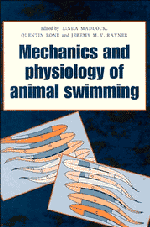Book contents
- Frontmatter
- Contents
- Contributors
- Introduction
- 1 Functional patterns of swimming bacteria
- 2 Buoyancy and swimming in marine planktonic protists
- 3 The role of fins in the competition between squid and fish
- 4 The biology of fish swimming
- 5 Swimming physiology of pelagic fishes
- 6 The mechanical design of the fish muscular system
- 7 How do fish use their myotomal muscle to swim? In vitro simulations of in vivo activity patterns
- 8 The timing of lateral muscle strain and EMG activity in different species of steadily swimming fish
- 9 Swimming in the lamprey: modelling the neural pattern generation, the body dynamics and the fluid mechanics
- 10 Swimming capabilities of Mesozoic marine reptiles: a review
- 11 Stone, bone or blubber? Buoyancy control strategies in aquatic tetrapods
- 12 Functional anatomy of the ‘flight’ apparatus in penguins
- 13 Energy conservation by formation swimming: metabolic evidence from ducklings
- Bibliography
- Index
10 - Swimming capabilities of Mesozoic marine reptiles: a review
Published online by Cambridge University Press: 05 March 2012
- Frontmatter
- Contents
- Contributors
- Introduction
- 1 Functional patterns of swimming bacteria
- 2 Buoyancy and swimming in marine planktonic protists
- 3 The role of fins in the competition between squid and fish
- 4 The biology of fish swimming
- 5 Swimming physiology of pelagic fishes
- 6 The mechanical design of the fish muscular system
- 7 How do fish use their myotomal muscle to swim? In vitro simulations of in vivo activity patterns
- 8 The timing of lateral muscle strain and EMG activity in different species of steadily swimming fish
- 9 Swimming in the lamprey: modelling the neural pattern generation, the body dynamics and the fluid mechanics
- 10 Swimming capabilities of Mesozoic marine reptiles: a review
- 11 Stone, bone or blubber? Buoyancy control strategies in aquatic tetrapods
- 12 Functional anatomy of the ‘flight’ apparatus in penguins
- 13 Energy conservation by formation swimming: metabolic evidence from ducklings
- Bibliography
- Index
Summary
Mesozoic marine reptiles noneed a range of swimming abilities. Jurassic and Cretaceous ichthyosaurs, with their deep, streamlined body, narrow caudal peduncle, and lunate tail, were probably efficient, fast sustained swimmers. The elongated bodies and long, broad tails of the early ichthyosaurs and mosasaurs (and marine crocodiles) suggest that they were adapted for rapid acceleration and were probably ambush predators. More problematic are the plesiosaurs, which utilized subaqueous flight using two pairs of wing-shaped appendages. The long-necked plesiosauroids were probably slow swimmers and relied on a sneak attack to capture prey. The pliosauroids, with shorter necks, more compact bodies, and larger, broader limbs were probably faster swimmers than the plesiosauroids.
By estimating the total drag and the amount of energy available for locomotion, relative sustained swimming capabilities can be estimated for reptiles of the same mass but different body forms. Calculations suggest that ichthyosaurs were faster than either plesiosaurs or mosasaurs, and plesiosaurs were slightly faster than mosasaurs. If the results are scaled to body length rather than mass, the differences in sustained swimming speeds are even more pronounced. Differences arise from estimates of hydrodynamic efficiency, shape, and metabolic rate for each kind of reptile, the latter being the most important factor.
INTRODUCTION
During the Mesozoic Era (245-65 million years ago) the large (>1 m) mobile predators in marine communities were reptiles. These included the ichthyosaurs (order Ichthyosauria), plesiosaurs and nothosaurs (order Sauropterygia), marine crocodiles (order Crocodylia: families Teleosauridae and Metriorhynchidae), mosasaurs (order Squamata: family Mosasauridae), placodonts (order Placodontia), and sea turtles (order Chelonia: family Protostegidae) (see Benton, 1990 for general discussion).
- Type
- Chapter
- Information
- The Mechanics and Physiology of Animal Swimming , pp. 133 - 150Publisher: Cambridge University PressPrint publication year: 1994
- 38
- Cited by



